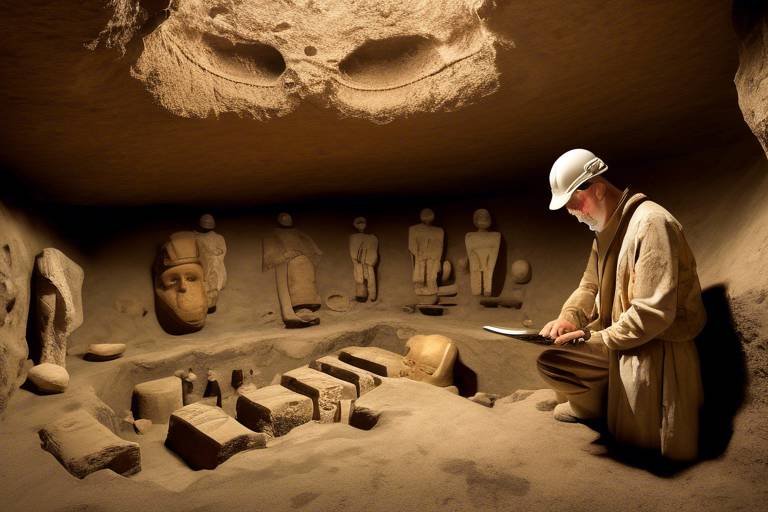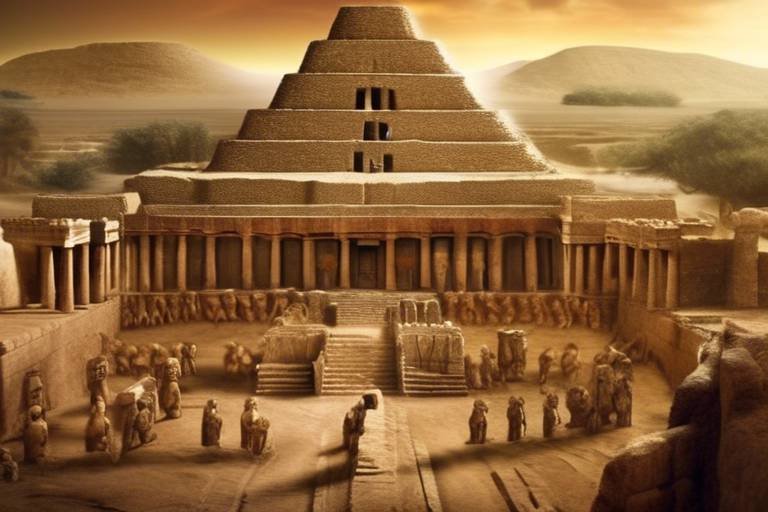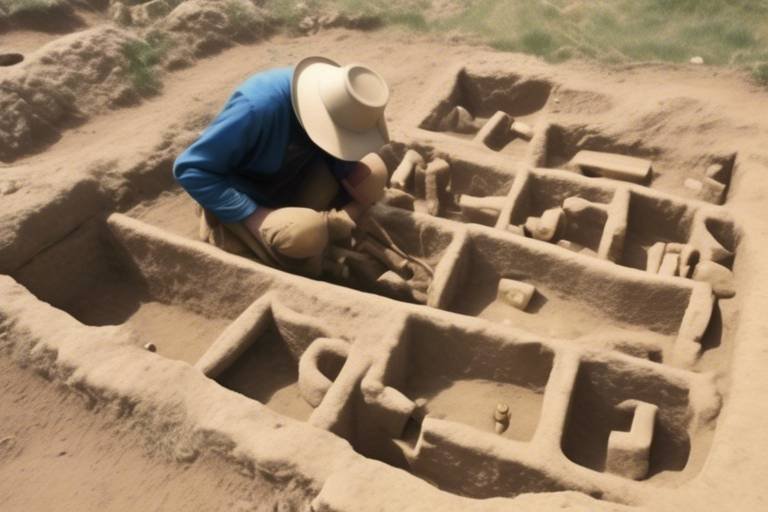How Ancient Civilizations Used Symbols in Their Art
Ancient civilizations have left behind a rich legacy of art filled with symbols that hold deep meanings and cultural significance. These symbols were not merely decorative elements but served as a language to convey stories, beliefs, and values of the societies that created them. By delving into the art of these past civilizations, we can unravel the mysteries behind these symbols and gain a deeper understanding of their artistic practices.
One of the most renowned examples of symbolic art can be found in Egyptian hieroglyphs. These intricate symbols were used by the ancient Egyptians to communicate narratives, religious beliefs, and historical events through a combination of pictorial representations and characters. Each hieroglyph carried a specific meaning, allowing the Egyptians to convey complex ideas and stories through their art.
Similarly, Mesoamerican civilizations such as the Maya and Aztecs utilized glyphs in their art to create elaborate writing systems. These glyphs were not just simple characters but intricate symbols that represented sounds, words, and concepts. Through the use of glyphs, these civilizations were able to document their history, religious practices, and cultural beliefs in a visually captivating manner.
Chinese calligraphy stands out as another example of symbolic art, where the written characters themselves were considered a form of art. In ancient Chinese culture, calligraphy served as a symbolic language, reflecting philosophical concepts, emotions, and aesthetic principles. The strokes and brushwork of Chinese calligraphy were not just letters but expressions of the artist's inner thoughts and feelings.
Ancient Greek art also incorporated a plethora of symbolic imagery, particularly in the depiction of mythological stories. Greek mythological symbols were used to represent gods, heroes, and mythical creatures, allowing artists to convey complex narratives through allegorical representations. These symbols served as visual metaphors that enriched the storytelling aspect of Greek art.
The symbols found in the art of the Indus Valley Civilization present a unique challenge to historians and archaeologists. The script used by this ancient civilization remains undeciphered, leaving behind a tantalizing mystery. The symbols in their art continue to intrigue scholars, who are tirelessly working to unlock the meaning and significance behind these enigmatic symbols.
Among the Norse people, runes played a vital role in their art and culture. These runic symbols were not just letters but held mystical significance, often associated with mythology, magic, and divination practices. The intricate designs of Norse runes were imbued with spiritual meanings that connected the Norse people to their ancient beliefs and traditions.
Native American tribes also left behind a rich legacy of symbolic art in the form of petroglyphs. These rock carvings served as a visual language, conveying spiritual beliefs, cultural heritage, and tribal histories. The symbolic meanings behind these petroglyphs offer a glimpse into the diverse cultures and traditions of Native American societies.
In African art and culture, Adinkra symbols hold a special place as visual representations of profound concepts and values. These intricate designs are used by various African ethnic groups for communication and representation, each symbol carrying a unique meaning. Adinkra symbols serve as a visual language that transcends barriers, conveying messages that resonate across different cultures and communities.

Egyptian Hieroglyphs
Exploring the significance of symbols in the art of ancient civilizations and how they were used to convey meanings, beliefs, and cultural values, providing insights into the artistic practices of past societies.
The use of hieroglyphs in ancient Egyptian art was a fundamental aspect of their culture. Hieroglyphs were not just simple symbols but a complex system of writing that conveyed stories, religious beliefs, and historical events. These intricate symbols and pictorial representations served as a means of communication, allowing the ancient Egyptians to record their rich history and express their cultural identity.

Mesoamerican Glyphs
Mesoamerican glyphs are a fascinating aspect of ancient civilizations, particularly those of the Maya and Aztecs. These intricate symbols served as a form of writing system, conveying complex messages and meanings through visually striking representations. The glyphs used by Mesoamerican cultures were not just simple characters but rather elaborate symbols that combined pictorial elements with abstract concepts. Each glyph carried a specific significance, ranging from historical events and religious beliefs to societal structures and astronomical knowledge.
One of the most intriguing aspects of Mesoamerican glyphs is their ability to convey both concrete and abstract ideas through a visual language. These symbols were not just used for communication but also served as a means of recording important information, such as genealogies, calendrical cycles, and ritual practices. The intricate nature of Mesoamerican glyphs reflects the advanced intellectual and artistic achievements of these ancient civilizations.
Furthermore, Mesoamerican glyphs were often incorporated into various art forms, including pottery, murals, and sculptures. These artistic expressions not only showcased the cultural richness of Mesoamerican societies but also provided valuable insights into their belief systems and worldview. By studying the glyphs found in Mesoamerican art, researchers can unravel the intricate tapestry of meanings embedded within these ancient symbols.

Chinese Calligraphy
Chinese calligraphy is a revered art form that goes beyond mere writing; it is a visual representation of the soul. The intricate strokes and flowing lines of Chinese characters convey not just words but also emotions, philosophies, and cultural values. Each brushstroke in Chinese calligraphy is intentional, reflecting the artist's state of mind and innermost thoughts.
Imagine a dance of ink on paper, where each movement tells a story, evokes a feeling, or captures a moment in time. Chinese calligraphy is a harmonious blend of form and meaning, where the shape of a character is as important as its message. It is a form of expression that transcends language barriers, speaking directly to the heart of the viewer.
In ancient Chinese culture, calligraphy was not just a means of communication but also a way to cultivate one's character and connect with the divine. The art of calligraphy was believed to bring harmony and balance to the artist's life, serving as a form of meditation and self-expression.
Chinese calligraphy is deeply rooted in philosophical concepts such as Taoism and Confucianism, with each brushstroke embodying the principles of balance, harmony, and unity. The fluidity of the ink symbolizes the ever-changing nature of existence, while the boldness of the strokes conveys strength and vitality.
Through the art of calligraphy, ancient Chinese scholars and artists sought to capture the essence of the natural world, expressing the beauty of mountains, rivers, and clouds in their writing. Each character was imbued with symbolic meaning, representing not just words but also deeper truths about life, love, and the human experience.

Greek Mythological Symbols
The art of ancient Greece is rich with mythological symbols that not only served as decorative elements but also carried deep meanings and stories from Greek mythology. These symbols were intricately woven into various art forms, including pottery, sculpture, and architecture, to convey the tales of gods, heroes, and mythical creatures.
One of the most iconic symbols in Greek mythology is the caduceus, a staff entwined with two serpents and topped with wings, often associated with Hermes, the messenger of the gods. This symbol represented commerce, negotiation, and eloquence, reflecting the attributes of Hermes as a mediator between the mortal and divine realms.
Another prominent symbol is the trident wielded by Poseidon, the god of the sea. The trident symbolized power and control over the waters, reflecting Poseidon's authority as a formidable deity ruling the oceans and earthquakes.
The laurel wreath was a symbol of victory and honor in Greek mythology, often worn by gods, heroes, and victorious athletes. It signified achievement, glory, and recognition of one's accomplishments, embodying the pursuit of excellence and success in various endeavors.
Depictions of the Gorgon, with its serpent hair and petrifying gaze, served as a powerful protective symbol in Greek art. The image of the Gorgon, such as Medusa, was believed to ward off evil and protect against harm, making it a popular motif in architecture and personal adornments.
Furthermore, the olive branch symbolized peace and harmony in Greek culture, often associated with Athena, the goddess of wisdom and warfare. The olive tree, along with its branches and leaves, represented prosperity, fertility, and the olive oil essential for sustenance and rituals.
In Greek art, these mythological symbols were not merely decorative elements but served as visual narratives that conveyed the values, beliefs, and heroic tales of ancient Greece, enriching the artistic expressions with layers of meaning and cultural significance.

Indus Valley Script
The Indus Valley Civilization, one of the oldest urban civilizations in history, left behind a mysterious script that continues to intrigue researchers and archaeologists. The symbols used in the Indus Valley script are a unique form of communication that has yet to be fully deciphered. These symbols, found on seals, pottery, and other artifacts, suggest a sophisticated writing system that was likely used for administrative and religious purposes.
Despite numerous attempts to crack the code of the Indus Valley script, the meaning and significance of these symbols remain elusive. Scholars have proposed various theories regarding the script's possible connection to spoken language, trade, or even religious rituals. The intricate nature of the symbols indicates a high level of organization and cultural sophistication within the ancient Indus Valley civilization.
One of the challenges in deciphering the Indus Valley script lies in the absence of a bilingual text or a Rosetta Stone-like artifact that could provide a key to understanding the symbols. Without a clear understanding of the language or context in which the script was used, researchers are left to speculate about its purpose and meaning.
Recent advancements in technology, such as computational analysis and machine learning algorithms, have offered new hope in unraveling the mysteries of the Indus Valley script. By analyzing patterns, frequencies, and correlations within the symbols, researchers are making progress in identifying potential linguistic features and semantic structures embedded in the script.
Despite the ongoing efforts to decode the Indus Valley script, much of its meaning remains shrouded in mystery. The symbols continue to serve as a tantalizing puzzle that offers insights into the ancient civilization's cultural practices, beliefs, and societal organization. Unlocking the secrets of the Indus Valley script could provide a deeper understanding of this enigmatic civilization and shed light on its contributions to the development of early writing systems.

Norse Runes
The use of runic symbols in Norse art and culture holds a deep significance, reflecting the rich mythology, magic, and divination practices of ancient Norse society. These ancient symbols, known as , were not merely letters but carried profound meanings and connections to the spiritual world. Each rune symbolized a concept, an object, or a force of nature, making them a powerful tool for communication and mystical purposes.
Similar to other ancient civilizations, the Norse people believed that symbols held a special power, capable of influencing the physical and spiritual realms. The runic symbols were often inscribed on various objects, from weapons to amulets, as a form of protection, guidance, or invocation of divine forces. The intricate designs of the runes were not just decorative but served as a direct link to the mystical beliefs and practices of the Norse culture.
Moreover, the use of Norse Runes extended beyond mere communication or decoration. In Norse mythology, the runes were believed to be gifts from the god Odin, who discovered them after a mystical experience of self-sacrifice. This connection to a divine origin elevated the runes to a sacred status, with each symbol embodying a piece of ancient wisdom, magic, or prophecy.
Interpreting the meanings of Norse Runes was not a simple task; it required a deep understanding of the symbolic language and the context in which the symbols were used. Shamans, known as seers or volvas, were responsible for deciphering the runic inscriptions and harnessing their mystical powers for rituals, spells, or divination practices. The intricate knowledge of the runes was passed down through generations, ensuring their preservation and continuity in Norse culture.
Today, the legacy of Norse Runes continues to captivate scholars, artists, and enthusiasts alike, with ongoing efforts to study, interpret, and revive the ancient symbols in modern contexts. The runes serve as a bridge between the past and the present, offering insights into the spiritual beliefs, cultural practices, and artistic expressions of the Norse civilization.

Native American Petroglyphs
Native American petroglyphs are a fascinating form of art that provides a glimpse into the cultural and spiritual beliefs of various Native American tribes. These rock carvings, etched into stone surfaces, serve as a visual language that conveys symbolic meanings and stories passed down through generations. Each petroglyph holds significance, representing aspects of daily life, spiritual practices, and connections to the natural world.
One common motif found in Native American petroglyphs is the depiction of animals such as deer, birds, and snakes, each carrying symbolic meanings specific to the tribe creating the artwork. These animal symbols often represent qualities like strength, wisdom, or protection, reflecting the deep connection Native Americans had with nature and the spiritual realm.
Moreover, geometric patterns and abstract symbols are prevalent in Native American petroglyphs, showcasing intricate designs that hold cultural significance and convey messages related to tribal customs, rituals, and belief systems. These symbols serve as a visual record of the tribe's history and traditions, preserving their heritage for future generations to interpret and appreciate.
Through the study of Native American petroglyphs, archaeologists and historians gain valuable insights into the daily life, spiritual practices, and artistic expressions of indigenous peoples. The intricate carvings provide a window into the worldviews and belief systems of Native American tribes, offering a unique perspective on their cultural identity and connection to the land.

African Adinkra Symbols
African Adinkra symbols hold a deep significance in the art and culture of various African ethnic groups, serving as visual representations of proverbs, historical events, and philosophical concepts. These intricate symbols are not merely decorative but carry layers of meaning that convey messages and values within the community. Adinkra symbols are often used in textiles, pottery, and architecture, showcasing the rich cultural heritage of African societies.
The Adinkra symbols are characterized by their geometric shapes and intricate designs, each symbol with its unique meaning and representation. For example, the "Sankofa" symbol, depicted as a bird with its head turned backward, symbolizes the importance of learning from the past to move forward. Similarly, the "Gye Nyame" symbol, shaped like a rotating cross, represents the supremacy of God in all aspects of life.
These symbols are not just aesthetically pleasing but serve as a form of communication and expression within African communities. They are often used in ceremonies, rituals, and everyday life to convey messages of wisdom, courage, and unity. The Adinkra symbols are a visual language that transcends barriers of spoken word, connecting individuals through shared cultural understanding.
Furthermore, the Adinkra symbols are deeply rooted in tradition and history, with each symbol carrying a legacy of stories and beliefs passed down through generations. The intricate patterns and symbolic meanings of Adinkra symbols reflect the values and worldview of African societies, offering insights into their spiritual beliefs and social structures.
In conclusion, African Adinkra symbols are not just decorative elements in art but are powerful symbols that encapsulate the wisdom, heritage, and cultural identity of African communities. These symbols serve as a visual language that transcends time and space, conveying profound messages of unity, resilience, and collective memory.
Frequently Asked Questions
- What is the significance of symbols in ancient art?
The symbols used in ancient art served as a means of communication, conveying stories, beliefs, and cultural values of past civilizations. They provided insights into the artistic practices and societal norms of ancient societies.
- How were symbols used in Egyptian hieroglyphs?
Egyptian hieroglyphs were intricate symbols used in ancient Egyptian art to communicate stories, religious beliefs, and historical events. They played a vital role in preserving the rich history and cultural heritage of Egypt.
- What do Mesoamerican glyphs represent?
Mesoamerican glyphs, such as those used by the Maya and Aztecs, represented complex writing systems and symbolic meanings in their art. These glyphs often depicted historical events, religious practices, and cultural traditions of these civilizations.
- How did Chinese calligraphy reflect ancient Chinese culture?
Chinese calligraphy served as a symbolic language in ancient Chinese culture, reflecting philosophical concepts, emotions, and aesthetic principles. It was a form of artistic expression that held deep cultural significance.
- What stories do Greek mythological symbols tell?
Greek mythological symbols depicted the stories of gods, heroes, and mythical creatures in ancient Greek art. These symbols conveyed allegorical representations and provided insights into the mythological beliefs of the ancient Greeks.
- What efforts are being made to decipher the Indus Valley script?
Ongoing efforts are being made to decipher the mysterious script of the Indus Valley Civilization. Scholars and archaeologists are studying the symbols used in their art to unravel the meaning and significance of these ancient symbols.
- How were Norse runes used in ancient Norse society?
Norse runes were symbols used in Norse art and culture, with connections to mythology, magic, and divination practices. They played a significant role in shaping the spiritual beliefs and cultural practices of the ancient Norse people.
- What do Native American petroglyphs symbolize?
Native American petroglyphs symbolize cultural heritage and spiritual beliefs of various Native American tribes. These rock carvings preserve the traditions and stories of indigenous peoples, offering insights into their rich cultural heritage.
- How are Adinkra symbols used in African art and culture?
Adinkra symbols are intricate designs used by various African ethnic groups for communication and representation in art. These symbols hold symbolic meanings and cultural significance, reflecting the diverse traditions and beliefs of African communities.



















